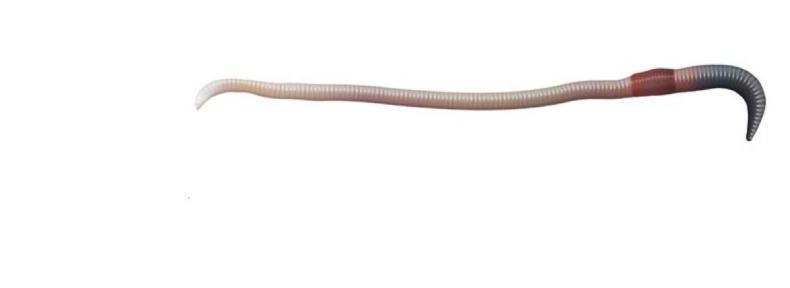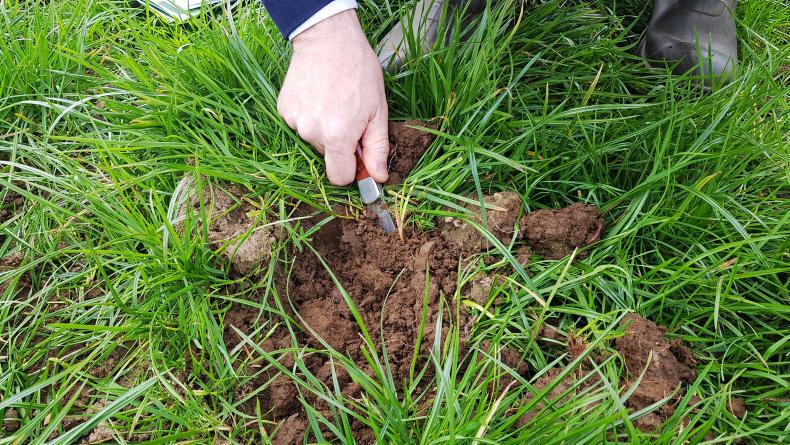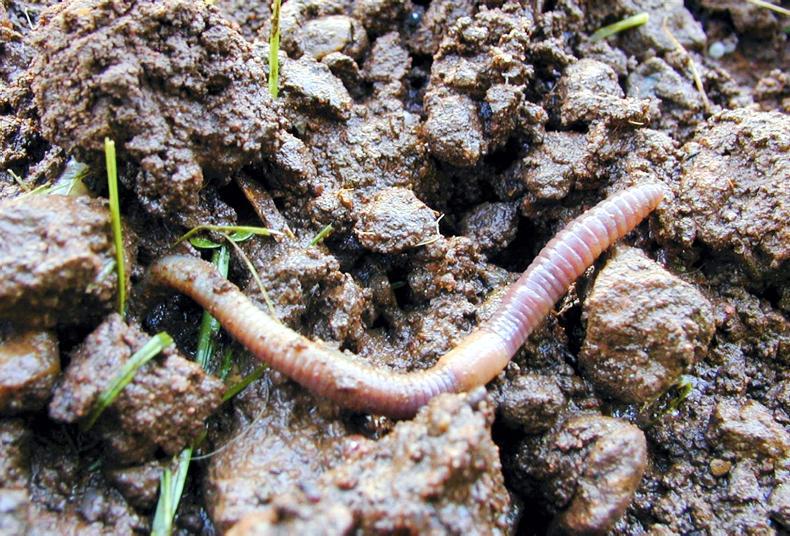Earthworms are vital components in the soil engine. They are principally responsible for engineering the soil environment, they manage and mix surface trash and are an important food source for many animal species.
Earthworms are a key indicator of soil health and are affected by pH, waterlogging, compaction, tillage, rotation and organic matter management.
Research by the AHDB shows that high numbers of earthworms indicate the potential for significant benefits to plant productivity. A good presence of earthworms across a field means the benefits are likely to be widespread.
There are up to 10 common earthworm species in agricultural soils
If earthworm populations are low, then corrective action will need to be taken to increase numbers in your soil.
There are up to 10 common earthworm species in agricultural soils and these can be grouped into three ecological types: epigeic, endogeic and anecic earthworms – each group having a unique and important function.
The presence of each ecological group indicates the potential for specific earthworm benefits, such as carbon cycling, nutrient mobilisation and/or water infiltration.
How to identify earthworms
Below are the key characteristics of species found in the three ecological categories:
Epigeic (litter-dwelling earthworms)

Epigeic type
Dark red-headed worms.Small (<8cm) in size, typically about the length of a matchstick.Often fast-moving. Sensitive to: Tillage (detrimental) and organic matter management such as manure applications (beneficial).
Roles: Carbon cycling and prey for native birds.
Endogeic (topsoil earthworms)

Endogeic type
Pale-coloured and green in colour (not red).Small to medium size.Often curl up when handled and green worms may emit a yellow fluid.The most common earthworm group found in arable fields.Sensitive to: Organic matter management (beneficial).
Roles: Soil aggregation and nutrient mobilisation for plants.
Anecic (deep burrowing earthworms)

Anecic type
Dark red or black-headed worms.Large size (>8cm), typically similar size to a pencil.Make deep vertical tunnels, up to 2m.Often found below surface earthworm casts or midden residue piles.Feed at night, foraging the soil surface around their burrow for litter.Commonly found in grassland but often absent from ploughed fields and where there is no surface litter. Sensitive to: Tillage (detrimental) and organic matter management such as manure applications and straw return (beneficial).
Roles: Deep burrows that improve aeration, water infiltration and root development.
Identifying adults and juveniles
The AHDB explains that adult earthworms have a clearly developed saddle (reproductive ring) and juveniles do not.

Adult earthworms have a defined saddle
You may need to rinse worms with water to determine if a saddle is present. Size is not a good indicator of maturity, as adult earthworms typically range from 2cm to 15cm in size, depending on species.
Assessing earthworm populations
Spring and autumn are the best times to carry out earthworm assessments. Timing the sampling after warm, wet conditions often provides the best earthworm population estimates.

You should sample following the standard W-shaped field-sampling pattern.
Procedure: Dig 10 soil pits per field following a standard W-shaped field-sampling pattern. Aim to spend five minutes hand-sorting the soil from each pit.
1. Dig out a soil pit (20cm x 20cm x 20cm) and place soil on mat.2. Hand-sort the soil, placing each whole earthworm into the pot.3. Count and record the total number of earthworms.4. Separate earthworms into adults and juveniles (see above).5. Return juveniles to the soil pit.6. Count and record the number of each type of adult earthworm.7. Return earthworms to the soil pit and backfill with soil.8. Repeat steps 1–7, until 10 soil pits per field have been assessed.Recording
Record the results of the count in the following template.

Recording earthworm populations.
Results
Next, compare the results of the count with the green, red and amber signals below.

Earthworm results analysis.
What does this mean
You should aim for green or amber signals in all of the above questions.
Red signals suggest suboptimal earthworm populations, which can indicate problems with the soil’s physical or chemical properties
Poor or patchy presence of earthworms suggests you could make improvements in the parts of the field where earthworms are not currently present.

A healthy earthworm population is vital for healthy soils.
The most significant benefits to plant productivity are more likely in fields where you find high numbers of earthworms.
If you are unlikely to find epigeic, endogeic or anecic earthworms, you are unlikely to be benefiting from their specific actions.
Earthworms are vital components in the soil engine. They are principally responsible for engineering the soil environment, they manage and mix surface trash and are an important food source for many animal species.
Earthworms are a key indicator of soil health and are affected by pH, waterlogging, compaction, tillage, rotation and organic matter management.
Research by the AHDB shows that high numbers of earthworms indicate the potential for significant benefits to plant productivity. A good presence of earthworms across a field means the benefits are likely to be widespread.
There are up to 10 common earthworm species in agricultural soils
If earthworm populations are low, then corrective action will need to be taken to increase numbers in your soil.
There are up to 10 common earthworm species in agricultural soils and these can be grouped into three ecological types: epigeic, endogeic and anecic earthworms – each group having a unique and important function.
The presence of each ecological group indicates the potential for specific earthworm benefits, such as carbon cycling, nutrient mobilisation and/or water infiltration.
How to identify earthworms
Below are the key characteristics of species found in the three ecological categories:
Epigeic (litter-dwelling earthworms)

Epigeic type
Dark red-headed worms.Small (<8cm) in size, typically about the length of a matchstick.Often fast-moving. Sensitive to: Tillage (detrimental) and organic matter management such as manure applications (beneficial).
Roles: Carbon cycling and prey for native birds.
Endogeic (topsoil earthworms)

Endogeic type
Pale-coloured and green in colour (not red).Small to medium size.Often curl up when handled and green worms may emit a yellow fluid.The most common earthworm group found in arable fields.Sensitive to: Organic matter management (beneficial).
Roles: Soil aggregation and nutrient mobilisation for plants.
Anecic (deep burrowing earthworms)

Anecic type
Dark red or black-headed worms.Large size (>8cm), typically similar size to a pencil.Make deep vertical tunnels, up to 2m.Often found below surface earthworm casts or midden residue piles.Feed at night, foraging the soil surface around their burrow for litter.Commonly found in grassland but often absent from ploughed fields and where there is no surface litter. Sensitive to: Tillage (detrimental) and organic matter management such as manure applications and straw return (beneficial).
Roles: Deep burrows that improve aeration, water infiltration and root development.
Identifying adults and juveniles
The AHDB explains that adult earthworms have a clearly developed saddle (reproductive ring) and juveniles do not.

Adult earthworms have a defined saddle
You may need to rinse worms with water to determine if a saddle is present. Size is not a good indicator of maturity, as adult earthworms typically range from 2cm to 15cm in size, depending on species.
Assessing earthworm populations
Spring and autumn are the best times to carry out earthworm assessments. Timing the sampling after warm, wet conditions often provides the best earthworm population estimates.

You should sample following the standard W-shaped field-sampling pattern.
Procedure: Dig 10 soil pits per field following a standard W-shaped field-sampling pattern. Aim to spend five minutes hand-sorting the soil from each pit.
1. Dig out a soil pit (20cm x 20cm x 20cm) and place soil on mat.2. Hand-sort the soil, placing each whole earthworm into the pot.3. Count and record the total number of earthworms.4. Separate earthworms into adults and juveniles (see above).5. Return juveniles to the soil pit.6. Count and record the number of each type of adult earthworm.7. Return earthworms to the soil pit and backfill with soil.8. Repeat steps 1–7, until 10 soil pits per field have been assessed.Recording
Record the results of the count in the following template.

Recording earthworm populations.
Results
Next, compare the results of the count with the green, red and amber signals below.

Earthworm results analysis.
What does this mean
You should aim for green or amber signals in all of the above questions.
Red signals suggest suboptimal earthworm populations, which can indicate problems with the soil’s physical or chemical properties
Poor or patchy presence of earthworms suggests you could make improvements in the parts of the field where earthworms are not currently present.

A healthy earthworm population is vital for healthy soils.
The most significant benefits to plant productivity are more likely in fields where you find high numbers of earthworms.
If you are unlikely to find epigeic, endogeic or anecic earthworms, you are unlikely to be benefiting from their specific actions.














 This is a subscriber-only article
This is a subscriber-only article










SHARING OPTIONS: